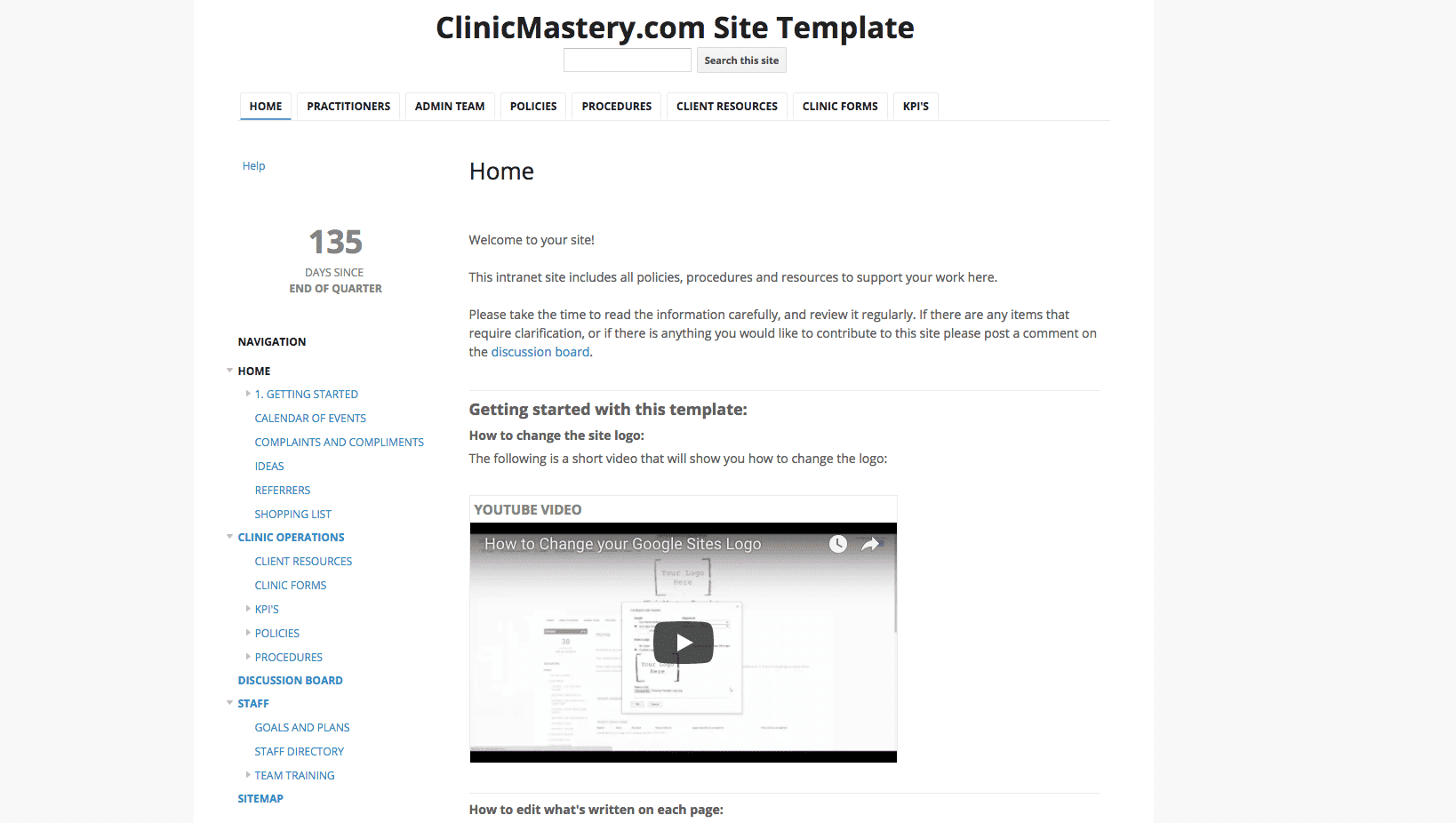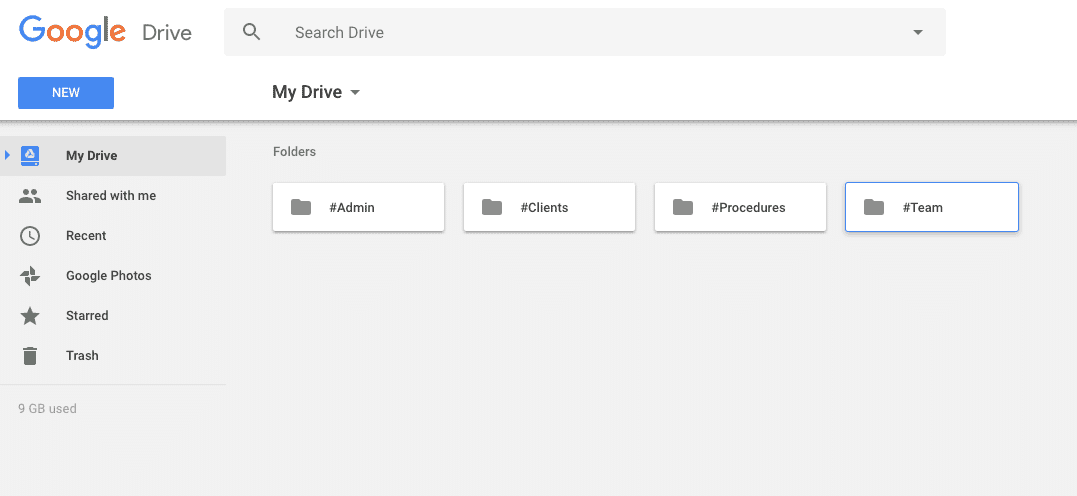Brand & Marketing
•
20 min read
•
Jan 28, 2018
Attract New Patients: 7 Step Content Marketing System
Grow Your Clinic With Content Marketing
We know that many private practice clinic owners have not implemented a content marketing system that allows them to frequently deliver high quality content, and so they often fall short in their ability to attract the right type and volume of new patients.
It’s hard enough trying to create and then implement quality systems around some of the fundamental clinic operations, let alone get time for producing quality marketing.
We’ve previously spoken about the value of having a content marketing system as part of your patient attraction strategy, so now we’re going to outline how to implement the system.
Marketing doesn’t have to be scary, ambiguous or difficult if you take what you learn and put it into some simple, repeatable steps.
I know you didn’t get taught content marketing at University, but you did decided to go into business, so you must get up to speed if you want to Grow Your Clinic.
In this article we are going to outline the content marketing system we have shared with 100’s of private practice owners and delivered (done-for-you) as part of our Business Academy to help you attract more of your ideal patients and fill your appointment books.

7 Step Content Marketing System
You’re going to have to work hard and earn the right to get your audience’s attention, and once you have got it, then you need to deliver value for them!
So let’s jump into how we can create world-class content marketing system.
The absolute value for you in this blog is when you capture what we’ve got here and create a system.

Successfully Implement Systems in Your Clinic
A really common question that clinic owners ask is, how do I successfully implement systems in my business so that my team actually use them in a way that gets the desired result every single time.
When you implement systems into your clinic, you’re job is to keep it simple so that everyone on the team can consistently achieve the same results as you.
You’ll have more confidence to hand over responsibility to your team when there are easy to find and follow systems, because it means that you can focus on growing your clinic.
when you implement systems into your clinic, you're job is to keep it simple
If you’re ever frustrated that no one ever does the tasks around the clinic as good as you, so you decide just to do it yourself, then it’s time to let go of your ego, because you’ll never create the business or life you truly want.
After working with 100’s of private practice clinic owners, and as part of the Business Academy we’ve discovered how you can successfully implement systems in your clinic so that you can automate and delegate low level tasks, allowing you to focus on how you Grow Your Clinic.

In this article, I’m going to share with you how to write, implement, track and stay accountable to using systems in your clinic.
7 Reasons Why You Should Have Systems in Your Clinic
A good system beats a great person
Systems can be outworked regardless of who is there
Team changes, systems stay the same
Systems allow you to work on your business, not buried in it
Increased level of service delivery
Formation of new habits
Systems free us up to think about the next opportunity

Why You Don’t Use Systems
Im sure you’d agree that systemising your business is simple, but it’s not easy… It takes real work! What typically holds you back is that:
Writing systems takes too long
You don’t know where to start
You’re not sure what to put in the system
When it comes to consistently getting great results in your business, there’s no doubt about the importance of systems and structure.
Great clinic owners are very deliberate about the process of designing their future, they don’t leave it up to chance and they certainly don’t just hope that it will evolve naturally.
The problem is that as a clinic owner there is only so much you can do.
You’re passion is not enough, and there are real barriers to your time, energy, and resources.
If everything that happens in the business needs to go through you, you are the bottleneck, and you are slowing progress.
“Opportunity without structure is chaos” - Keith Cunningham
How To Grow By Consulting Less
I remember going from 6 days consulting as a podiatrist to none in 12 months. I got criticised, it took a lot of focus, but it was incredibly rewarding.
In fact, my plan started as a 5 year plan until a mentor challenged me to do it in 6 months.

My mentor also challenged me to replace my income, and also increase the bottom line in my business by 20% over the same time period.
That bit seemed unbelievable, but I have the results to prove it is possible.
I realised that I needed to invest more of myself into my team, create a wow experience for my clients, be more focused on working on my business, and be more present with my family.
I couldn’t do it all, and the answer for me was to take this journey of systemising the business – putting in place the structure for it to run successfully without me.
Systems Don’t Work For Us… is B.S.
I’ve heard people say this before, and I understand where it comes from, but digging deep into why they don’t work reveals the same thing every time:
The reality is that all of us already have systems in our business – it’s just that most systems are not easy to replicate or track.
If you feel like you are constantly putting out spot fires, running from one problem to the next, banging your head against the wall because team members are making silly decisions or doing silly things, or even if you are just tired of repeating yourself over and over then it’s time to implement some good systems.

What Makes A Quality System
A quality system is a procedure, designed to achieve an outcome that is consistent, measurable, and ultimately benefits your clients.
The key to making your systems work seamlessly is that they are easily accessible, relevant, and there is a trigger that tells your team members when it’s time to use the system.
“94% of all failure is a result of the system, not people.” E. Deming
We rely on our systems, and have a culture in our clinic where we blame the system, not the person.
The key to making your systems work seamlessly is that they are easily accessible, relevant, and there is a trigger.
Whenever there’s a problem, we look to the solution in the form of implementing a new system to make sure it will never be a problem again.
Systems allow you to build quality in your delivery. They are the essential building blocks of your company, whether you realise it or not.

The outcome of a good system is consistency, predictability and reliability. There’s safety in systems.
You can trust that systems will work. They will remove waste and inefficiency out of your business and help you give customers what they want every single time.
Even if your business is full of great people, you are still limited by their individual capabilities. That’s why you need great systems.
But, most of us as business owners are flying by the seat of our pants – because most of us don’t have the tools to be able to make the right decisions. It’s easier than you may think.
The best place to start is to document every process in your clinic and put them all in a place where everyone can access them.
You have a place to put the systems (Google Sites Template or Google Drive), so now I’d like to show you how to write the systems, and use them effectively.

What Systems Could You Create First
You could pick any process in your clinic and choose to systemise it:
Taking a message
Sending a letter
Doing a Special offer
Sending an appointment reminder
Backing up the computer
Paying the bills
Taking a phone call
If you’re struggling to know where to start, think of the top 5 things in your clinic that frustrate you, and write a systems around them.
Your systems always need to point towards a specific outcome or objective. That’s why when we write a system in our business we start with the end in mind.
5 Steps on How to Write a Quality System
Step 1 – The Outcome
You should always start with the end in mind, what are you hoping to achieve and why.
Step 2 – The Resources
Consider what is needed to make it happen. What tools or resources need to be made available to be able to successfully complete the procedure?
Step 3 – The Person Responsible
Identify the person or people who are responsible to do it.
Step 4 – The Steps
Write the simple steps to outline the procedure. Write down when to use the system, and include checklists or flowcharts to make it easy.
Step 5 – The Tracking
You need a way to monitor the results, with simple visual cues to know whether or not there is a problem with the system at one glance.
Example System
One thing that a lot of clinic owners find themselves doing is paying the bills, and it’s not an easy task to hand over. But, when you create a system around it, you’ll have a situation where you’ll never have to pay a bill in your business again… because someone else is doing it for you.
Step 1: The Outcome
All bills to be paid on time – not too early, and not late.
Step 2: Resources
An accessible bank account (If you’re worried about letting someone access the main account you can ask your bank to set up a “bills” account, and keep a nominal amount of money in it for bills).
You’ll also need 2 in-trays to keep all the bills that are outstanding, and the bills that are paid.
Access to your accounting software to enter the bills and record when paid
Step 3: Person Responsible
Nominate one person who’ll do this task regularly. It could be one of your team members, bookkeeper or virtual assistant.
Step 4: The Steps
Writing your steps on a Google Doc including pictures of your computer screen as you do each process
Flowchart the process (You might like to use LucidChart to do this)
Take a screencast video of you paying the bills on your computer (you could use Snagit or Jing to do this)
Or do all three and enter one or all of them on a page called “Paying Bills” under the “Procedures” tab in your Site.
(Remember to test the procedure by having the team member follow your instructions to see whether there are any problems with the instructions)
Step 5 The Tracking:
You might like to monitor which bills are being paid by adding a step to make sure you’ve signed the bills before they actually get paid
You can monitor if bills are being paid by checking the in-tray system, your accounting software, or the bank account
The beauty is the system is the same regardless of who is doing it.
Whatever process you decide to systemise in your business, write the system so anyone could do it.
If you follow those 5 steps and you will be on your way to organising your business around systems, and less exposed to problems if people come and go.
The key as a business owner is that you need to be working in a high earning capacity.
That means, time taken to pay the bills is not as valuable to your success as time taken to form relationships with potential referrers.
Systems like this allow you to be free to work on the things that matter.
Having proper procedures in place for the things that matter most, and in moments where there’s no specific system that applies, have policies that govern culture and attitude to work so your team know how to carry themselves in that moment.
What’s the Trigger for the System?!
So, now you have a system written, it’s time to work out what the trigger is to outwork the system.
I use google sites as the central place to keep the systems for our business, and then I use a tasks application called Asana as the trigger for when to follow the procedure.

For the example above, you could set up a trigger to do the task with a daily or weekly task to follow the “Paying a Bill” procedure (could be on a task list you set up in Asana, or just simply a particular day when the bills are done)
It doesn’t have to be technological though, it may work better for you to have a checklist on a piece of paper or a spreadsheet, but the main thing is that you are not leaving things to chance.
Just make sure that whenever something needs to be done there’s something in place to remind the person who needs to do it.
Why Your Systems Won’t Work
Your systems get confused with ‘just doing stuff’ and don’t actually benefit your team or your business.
You don’t follow through on your words with action.
Your systems are too clunky and can’t be replicated.
There isn’t a way to track the system and keep your team accountable.
Conclusion
Remember this, your systems are the essential life blood of your business, and you must value them as much as your business itself.
That was one of the hardest things for me because as the business owner I was so used to doing everything myself.
The good news is that it’s easier than you think, and doesn’t even take that long to do.
Let this be a moment where you decide to completely renovate your business from the ground up like you would with your house, not just patching over the cracks, but reinforcing the foundation, the frames, and structure to create something you want to live in.
Your team won’t be used to the changing pace of your business as you implement new systems, so you need to keep the conversation going, the communication flowing, and your door open to help them trust you more.
Follow through on what you say, and lead by example!
Let the systems run the business, and the people run the systems. People come and go, but the systems remain constant” – Michael Gerber
To empower your team to love your business as you do, you need to support them by creating systems that allow them to layer their own personality and flare.
Remember that if your business is reliant on you, and you don’t help your team to take care of the day to day operations, then you don’t own a business, you own a job.
By removing yourself as the bottleneck in the business and leveraging the strengths of each individual team member you can increase your capacity far beyond anything you dreamed.
If you believe that you’d benefit from more practical training on private practice growth, please join us for our free online masterclass. Until next time, remember to:
Live with Passion, because Everyday is an Opportunity for you to Make Your difference!
Grow Your Clinic With Content Marketing
We know that many private practice clinic owners have not implemented a content marketing system that allows them to frequently deliver high quality content, and so they often fall short in their ability to attract the right type and volume of new patients.
It’s hard enough trying to create and then implement quality systems around some of the fundamental clinic operations, let alone get time for producing quality marketing.
We’ve previously spoken about the value of having a content marketing system as part of your patient attraction strategy, so now we’re going to outline how to implement the system.
Marketing doesn’t have to be scary, ambiguous or difficult if you take what you learn and put it into some simple, repeatable steps.
I know you didn’t get taught content marketing at University, but you did decided to go into business, so you must get up to speed if you want to Grow Your Clinic.
In this article we are going to outline the content marketing system we have shared with 100’s of private practice owners and delivered (done-for-you) as part of our Business Academy to help you attract more of your ideal patients and fill your appointment books.

7 Step Content Marketing System
You’re going to have to work hard and earn the right to get your audience’s attention, and once you have got it, then you need to deliver value for them!
So let’s jump into how we can create world-class content marketing system.
The absolute value for you in this blog is when you capture what we’ve got here and create a system.

Successfully Implement Systems in Your Clinic
A really common question that clinic owners ask is, how do I successfully implement systems in my business so that my team actually use them in a way that gets the desired result every single time.
When you implement systems into your clinic, you’re job is to keep it simple so that everyone on the team can consistently achieve the same results as you.
You’ll have more confidence to hand over responsibility to your team when there are easy to find and follow systems, because it means that you can focus on growing your clinic.
when you implement systems into your clinic, you're job is to keep it simple
If you’re ever frustrated that no one ever does the tasks around the clinic as good as you, so you decide just to do it yourself, then it’s time to let go of your ego, because you’ll never create the business or life you truly want.
After working with 100’s of private practice clinic owners, and as part of the Business Academy we’ve discovered how you can successfully implement systems in your clinic so that you can automate and delegate low level tasks, allowing you to focus on how you Grow Your Clinic.

In this article, I’m going to share with you how to write, implement, track and stay accountable to using systems in your clinic.
7 Reasons Why You Should Have Systems in Your Clinic
A good system beats a great person
Systems can be outworked regardless of who is there
Team changes, systems stay the same
Systems allow you to work on your business, not buried in it
Increased level of service delivery
Formation of new habits
Systems free us up to think about the next opportunity

Why You Don’t Use Systems
Im sure you’d agree that systemising your business is simple, but it’s not easy… It takes real work! What typically holds you back is that:
Writing systems takes too long
You don’t know where to start
You’re not sure what to put in the system
When it comes to consistently getting great results in your business, there’s no doubt about the importance of systems and structure.
Great clinic owners are very deliberate about the process of designing their future, they don’t leave it up to chance and they certainly don’t just hope that it will evolve naturally.
The problem is that as a clinic owner there is only so much you can do.
You’re passion is not enough, and there are real barriers to your time, energy, and resources.
If everything that happens in the business needs to go through you, you are the bottleneck, and you are slowing progress.
“Opportunity without structure is chaos” - Keith Cunningham
How To Grow By Consulting Less
I remember going from 6 days consulting as a podiatrist to none in 12 months. I got criticised, it took a lot of focus, but it was incredibly rewarding.
In fact, my plan started as a 5 year plan until a mentor challenged me to do it in 6 months.

My mentor also challenged me to replace my income, and also increase the bottom line in my business by 20% over the same time period.
That bit seemed unbelievable, but I have the results to prove it is possible.
I realised that I needed to invest more of myself into my team, create a wow experience for my clients, be more focused on working on my business, and be more present with my family.
I couldn’t do it all, and the answer for me was to take this journey of systemising the business – putting in place the structure for it to run successfully without me.
Systems Don’t Work For Us… is B.S.
I’ve heard people say this before, and I understand where it comes from, but digging deep into why they don’t work reveals the same thing every time:
The reality is that all of us already have systems in our business – it’s just that most systems are not easy to replicate or track.
If you feel like you are constantly putting out spot fires, running from one problem to the next, banging your head against the wall because team members are making silly decisions or doing silly things, or even if you are just tired of repeating yourself over and over then it’s time to implement some good systems.

What Makes A Quality System
A quality system is a procedure, designed to achieve an outcome that is consistent, measurable, and ultimately benefits your clients.
The key to making your systems work seamlessly is that they are easily accessible, relevant, and there is a trigger that tells your team members when it’s time to use the system.
“94% of all failure is a result of the system, not people.” E. Deming
We rely on our systems, and have a culture in our clinic where we blame the system, not the person.
The key to making your systems work seamlessly is that they are easily accessible, relevant, and there is a trigger.
Whenever there’s a problem, we look to the solution in the form of implementing a new system to make sure it will never be a problem again.
Systems allow you to build quality in your delivery. They are the essential building blocks of your company, whether you realise it or not.

The outcome of a good system is consistency, predictability and reliability. There’s safety in systems.
You can trust that systems will work. They will remove waste and inefficiency out of your business and help you give customers what they want every single time.
Even if your business is full of great people, you are still limited by their individual capabilities. That’s why you need great systems.
But, most of us as business owners are flying by the seat of our pants – because most of us don’t have the tools to be able to make the right decisions. It’s easier than you may think.
The best place to start is to document every process in your clinic and put them all in a place where everyone can access them.
You have a place to put the systems (Google Sites Template or Google Drive), so now I’d like to show you how to write the systems, and use them effectively.

What Systems Could You Create First
You could pick any process in your clinic and choose to systemise it:
Taking a message
Sending a letter
Doing a Special offer
Sending an appointment reminder
Backing up the computer
Paying the bills
Taking a phone call
If you’re struggling to know where to start, think of the top 5 things in your clinic that frustrate you, and write a systems around them.
Your systems always need to point towards a specific outcome or objective. That’s why when we write a system in our business we start with the end in mind.
5 Steps on How to Write a Quality System
Step 1 – The Outcome
You should always start with the end in mind, what are you hoping to achieve and why.
Step 2 – The Resources
Consider what is needed to make it happen. What tools or resources need to be made available to be able to successfully complete the procedure?
Step 3 – The Person Responsible
Identify the person or people who are responsible to do it.
Step 4 – The Steps
Write the simple steps to outline the procedure. Write down when to use the system, and include checklists or flowcharts to make it easy.
Step 5 – The Tracking
You need a way to monitor the results, with simple visual cues to know whether or not there is a problem with the system at one glance.
Example System
One thing that a lot of clinic owners find themselves doing is paying the bills, and it’s not an easy task to hand over. But, when you create a system around it, you’ll have a situation where you’ll never have to pay a bill in your business again… because someone else is doing it for you.
Step 1: The Outcome
All bills to be paid on time – not too early, and not late.
Step 2: Resources
An accessible bank account (If you’re worried about letting someone access the main account you can ask your bank to set up a “bills” account, and keep a nominal amount of money in it for bills).
You’ll also need 2 in-trays to keep all the bills that are outstanding, and the bills that are paid.
Access to your accounting software to enter the bills and record when paid
Step 3: Person Responsible
Nominate one person who’ll do this task regularly. It could be one of your team members, bookkeeper or virtual assistant.
Step 4: The Steps
Writing your steps on a Google Doc including pictures of your computer screen as you do each process
Flowchart the process (You might like to use LucidChart to do this)
Take a screencast video of you paying the bills on your computer (you could use Snagit or Jing to do this)
Or do all three and enter one or all of them on a page called “Paying Bills” under the “Procedures” tab in your Site.
(Remember to test the procedure by having the team member follow your instructions to see whether there are any problems with the instructions)
Step 5 The Tracking:
You might like to monitor which bills are being paid by adding a step to make sure you’ve signed the bills before they actually get paid
You can monitor if bills are being paid by checking the in-tray system, your accounting software, or the bank account
The beauty is the system is the same regardless of who is doing it.
Whatever process you decide to systemise in your business, write the system so anyone could do it.
If you follow those 5 steps and you will be on your way to organising your business around systems, and less exposed to problems if people come and go.
The key as a business owner is that you need to be working in a high earning capacity.
That means, time taken to pay the bills is not as valuable to your success as time taken to form relationships with potential referrers.
Systems like this allow you to be free to work on the things that matter.
Having proper procedures in place for the things that matter most, and in moments where there’s no specific system that applies, have policies that govern culture and attitude to work so your team know how to carry themselves in that moment.
What’s the Trigger for the System?!
So, now you have a system written, it’s time to work out what the trigger is to outwork the system.
I use google sites as the central place to keep the systems for our business, and then I use a tasks application called Asana as the trigger for when to follow the procedure.

For the example above, you could set up a trigger to do the task with a daily or weekly task to follow the “Paying a Bill” procedure (could be on a task list you set up in Asana, or just simply a particular day when the bills are done)
It doesn’t have to be technological though, it may work better for you to have a checklist on a piece of paper or a spreadsheet, but the main thing is that you are not leaving things to chance.
Just make sure that whenever something needs to be done there’s something in place to remind the person who needs to do it.
Why Your Systems Won’t Work
Your systems get confused with ‘just doing stuff’ and don’t actually benefit your team or your business.
You don’t follow through on your words with action.
Your systems are too clunky and can’t be replicated.
There isn’t a way to track the system and keep your team accountable.
Conclusion
Remember this, your systems are the essential life blood of your business, and you must value them as much as your business itself.
That was one of the hardest things for me because as the business owner I was so used to doing everything myself.
The good news is that it’s easier than you think, and doesn’t even take that long to do.
Let this be a moment where you decide to completely renovate your business from the ground up like you would with your house, not just patching over the cracks, but reinforcing the foundation, the frames, and structure to create something you want to live in.
Your team won’t be used to the changing pace of your business as you implement new systems, so you need to keep the conversation going, the communication flowing, and your door open to help them trust you more.
Follow through on what you say, and lead by example!
Let the systems run the business, and the people run the systems. People come and go, but the systems remain constant” – Michael Gerber
To empower your team to love your business as you do, you need to support them by creating systems that allow them to layer their own personality and flare.
Remember that if your business is reliant on you, and you don’t help your team to take care of the day to day operations, then you don’t own a business, you own a job.
By removing yourself as the bottleneck in the business and leveraging the strengths of each individual team member you can increase your capacity far beyond anything you dreamed.
If you believe that you’d benefit from more practical training on private practice growth, please join us for our free online masterclass. Until next time, remember to:
Live with Passion, because Everyday is an Opportunity for you to Make Your difference!
Grow Your Clinic With Content Marketing
We know that many private practice clinic owners have not implemented a content marketing system that allows them to frequently deliver high quality content, and so they often fall short in their ability to attract the right type and volume of new patients.
It’s hard enough trying to create and then implement quality systems around some of the fundamental clinic operations, let alone get time for producing quality marketing.
We’ve previously spoken about the value of having a content marketing system as part of your patient attraction strategy, so now we’re going to outline how to implement the system.
Marketing doesn’t have to be scary, ambiguous or difficult if you take what you learn and put it into some simple, repeatable steps.
I know you didn’t get taught content marketing at University, but you did decided to go into business, so you must get up to speed if you want to Grow Your Clinic.
In this article we are going to outline the content marketing system we have shared with 100’s of private practice owners and delivered (done-for-you) as part of our Business Academy to help you attract more of your ideal patients and fill your appointment books.

7 Step Content Marketing System
You’re going to have to work hard and earn the right to get your audience’s attention, and once you have got it, then you need to deliver value for them!
So let’s jump into how we can create world-class content marketing system.
The absolute value for you in this blog is when you capture what we’ve got here and create a system.

Successfully Implement Systems in Your Clinic
A really common question that clinic owners ask is, how do I successfully implement systems in my business so that my team actually use them in a way that gets the desired result every single time.
When you implement systems into your clinic, you’re job is to keep it simple so that everyone on the team can consistently achieve the same results as you.
You’ll have more confidence to hand over responsibility to your team when there are easy to find and follow systems, because it means that you can focus on growing your clinic.
when you implement systems into your clinic, you're job is to keep it simple
If you’re ever frustrated that no one ever does the tasks around the clinic as good as you, so you decide just to do it yourself, then it’s time to let go of your ego, because you’ll never create the business or life you truly want.
After working with 100’s of private practice clinic owners, and as part of the Business Academy we’ve discovered how you can successfully implement systems in your clinic so that you can automate and delegate low level tasks, allowing you to focus on how you Grow Your Clinic.

In this article, I’m going to share with you how to write, implement, track and stay accountable to using systems in your clinic.
7 Reasons Why You Should Have Systems in Your Clinic
A good system beats a great person
Systems can be outworked regardless of who is there
Team changes, systems stay the same
Systems allow you to work on your business, not buried in it
Increased level of service delivery
Formation of new habits
Systems free us up to think about the next opportunity

Why You Don’t Use Systems
Im sure you’d agree that systemising your business is simple, but it’s not easy… It takes real work! What typically holds you back is that:
Writing systems takes too long
You don’t know where to start
You’re not sure what to put in the system
When it comes to consistently getting great results in your business, there’s no doubt about the importance of systems and structure.
Great clinic owners are very deliberate about the process of designing their future, they don’t leave it up to chance and they certainly don’t just hope that it will evolve naturally.
The problem is that as a clinic owner there is only so much you can do.
You’re passion is not enough, and there are real barriers to your time, energy, and resources.
If everything that happens in the business needs to go through you, you are the bottleneck, and you are slowing progress.
“Opportunity without structure is chaos” - Keith Cunningham
How To Grow By Consulting Less
I remember going from 6 days consulting as a podiatrist to none in 12 months. I got criticised, it took a lot of focus, but it was incredibly rewarding.
In fact, my plan started as a 5 year plan until a mentor challenged me to do it in 6 months.

My mentor also challenged me to replace my income, and also increase the bottom line in my business by 20% over the same time period.
That bit seemed unbelievable, but I have the results to prove it is possible.
I realised that I needed to invest more of myself into my team, create a wow experience for my clients, be more focused on working on my business, and be more present with my family.
I couldn’t do it all, and the answer for me was to take this journey of systemising the business – putting in place the structure for it to run successfully without me.
Systems Don’t Work For Us… is B.S.
I’ve heard people say this before, and I understand where it comes from, but digging deep into why they don’t work reveals the same thing every time:
The reality is that all of us already have systems in our business – it’s just that most systems are not easy to replicate or track.
If you feel like you are constantly putting out spot fires, running from one problem to the next, banging your head against the wall because team members are making silly decisions or doing silly things, or even if you are just tired of repeating yourself over and over then it’s time to implement some good systems.

What Makes A Quality System
A quality system is a procedure, designed to achieve an outcome that is consistent, measurable, and ultimately benefits your clients.
The key to making your systems work seamlessly is that they are easily accessible, relevant, and there is a trigger that tells your team members when it’s time to use the system.
“94% of all failure is a result of the system, not people.” E. Deming
We rely on our systems, and have a culture in our clinic where we blame the system, not the person.
The key to making your systems work seamlessly is that they are easily accessible, relevant, and there is a trigger.
Whenever there’s a problem, we look to the solution in the form of implementing a new system to make sure it will never be a problem again.
Systems allow you to build quality in your delivery. They are the essential building blocks of your company, whether you realise it or not.

The outcome of a good system is consistency, predictability and reliability. There’s safety in systems.
You can trust that systems will work. They will remove waste and inefficiency out of your business and help you give customers what they want every single time.
Even if your business is full of great people, you are still limited by their individual capabilities. That’s why you need great systems.
But, most of us as business owners are flying by the seat of our pants – because most of us don’t have the tools to be able to make the right decisions. It’s easier than you may think.
The best place to start is to document every process in your clinic and put them all in a place where everyone can access them.
You have a place to put the systems (Google Sites Template or Google Drive), so now I’d like to show you how to write the systems, and use them effectively.

What Systems Could You Create First
You could pick any process in your clinic and choose to systemise it:
Taking a message
Sending a letter
Doing a Special offer
Sending an appointment reminder
Backing up the computer
Paying the bills
Taking a phone call
If you’re struggling to know where to start, think of the top 5 things in your clinic that frustrate you, and write a systems around them.
Your systems always need to point towards a specific outcome or objective. That’s why when we write a system in our business we start with the end in mind.
5 Steps on How to Write a Quality System
Step 1 – The Outcome
You should always start with the end in mind, what are you hoping to achieve and why.
Step 2 – The Resources
Consider what is needed to make it happen. What tools or resources need to be made available to be able to successfully complete the procedure?
Step 3 – The Person Responsible
Identify the person or people who are responsible to do it.
Step 4 – The Steps
Write the simple steps to outline the procedure. Write down when to use the system, and include checklists or flowcharts to make it easy.
Step 5 – The Tracking
You need a way to monitor the results, with simple visual cues to know whether or not there is a problem with the system at one glance.
Example System
One thing that a lot of clinic owners find themselves doing is paying the bills, and it’s not an easy task to hand over. But, when you create a system around it, you’ll have a situation where you’ll never have to pay a bill in your business again… because someone else is doing it for you.
Step 1: The Outcome
All bills to be paid on time – not too early, and not late.
Step 2: Resources
An accessible bank account (If you’re worried about letting someone access the main account you can ask your bank to set up a “bills” account, and keep a nominal amount of money in it for bills).
You’ll also need 2 in-trays to keep all the bills that are outstanding, and the bills that are paid.
Access to your accounting software to enter the bills and record when paid
Step 3: Person Responsible
Nominate one person who’ll do this task regularly. It could be one of your team members, bookkeeper or virtual assistant.
Step 4: The Steps
Writing your steps on a Google Doc including pictures of your computer screen as you do each process
Flowchart the process (You might like to use LucidChart to do this)
Take a screencast video of you paying the bills on your computer (you could use Snagit or Jing to do this)
Or do all three and enter one or all of them on a page called “Paying Bills” under the “Procedures” tab in your Site.
(Remember to test the procedure by having the team member follow your instructions to see whether there are any problems with the instructions)
Step 5 The Tracking:
You might like to monitor which bills are being paid by adding a step to make sure you’ve signed the bills before they actually get paid
You can monitor if bills are being paid by checking the in-tray system, your accounting software, or the bank account
The beauty is the system is the same regardless of who is doing it.
Whatever process you decide to systemise in your business, write the system so anyone could do it.
If you follow those 5 steps and you will be on your way to organising your business around systems, and less exposed to problems if people come and go.
The key as a business owner is that you need to be working in a high earning capacity.
That means, time taken to pay the bills is not as valuable to your success as time taken to form relationships with potential referrers.
Systems like this allow you to be free to work on the things that matter.
Having proper procedures in place for the things that matter most, and in moments where there’s no specific system that applies, have policies that govern culture and attitude to work so your team know how to carry themselves in that moment.
What’s the Trigger for the System?!
So, now you have a system written, it’s time to work out what the trigger is to outwork the system.
I use google sites as the central place to keep the systems for our business, and then I use a tasks application called Asana as the trigger for when to follow the procedure.

For the example above, you could set up a trigger to do the task with a daily or weekly task to follow the “Paying a Bill” procedure (could be on a task list you set up in Asana, or just simply a particular day when the bills are done)
It doesn’t have to be technological though, it may work better for you to have a checklist on a piece of paper or a spreadsheet, but the main thing is that you are not leaving things to chance.
Just make sure that whenever something needs to be done there’s something in place to remind the person who needs to do it.
Why Your Systems Won’t Work
Your systems get confused with ‘just doing stuff’ and don’t actually benefit your team or your business.
You don’t follow through on your words with action.
Your systems are too clunky and can’t be replicated.
There isn’t a way to track the system and keep your team accountable.
Conclusion
Remember this, your systems are the essential life blood of your business, and you must value them as much as your business itself.
That was one of the hardest things for me because as the business owner I was so used to doing everything myself.
The good news is that it’s easier than you think, and doesn’t even take that long to do.
Let this be a moment where you decide to completely renovate your business from the ground up like you would with your house, not just patching over the cracks, but reinforcing the foundation, the frames, and structure to create something you want to live in.
Your team won’t be used to the changing pace of your business as you implement new systems, so you need to keep the conversation going, the communication flowing, and your door open to help them trust you more.
Follow through on what you say, and lead by example!
Let the systems run the business, and the people run the systems. People come and go, but the systems remain constant” – Michael Gerber
To empower your team to love your business as you do, you need to support them by creating systems that allow them to layer their own personality and flare.
Remember that if your business is reliant on you, and you don’t help your team to take care of the day to day operations, then you don’t own a business, you own a job.
By removing yourself as the bottleneck in the business and leveraging the strengths of each individual team member you can increase your capacity far beyond anything you dreamed.
If you believe that you’d benefit from more practical training on private practice growth, please join us for our free online masterclass. Until next time, remember to:
Live with Passion, because Everyday is an Opportunity for you to Make Your difference!
Grow Your Clinic With Content Marketing
We know that many private practice clinic owners have not implemented a content marketing system that allows them to frequently deliver high quality content, and so they often fall short in their ability to attract the right type and volume of new patients.
It’s hard enough trying to create and then implement quality systems around some of the fundamental clinic operations, let alone get time for producing quality marketing.
We’ve previously spoken about the value of having a content marketing system as part of your patient attraction strategy, so now we’re going to outline how to implement the system.
Marketing doesn’t have to be scary, ambiguous or difficult if you take what you learn and put it into some simple, repeatable steps.
I know you didn’t get taught content marketing at University, but you did decided to go into business, so you must get up to speed if you want to Grow Your Clinic.
In this article we are going to outline the content marketing system we have shared with 100’s of private practice owners and delivered (done-for-you) as part of our Business Academy to help you attract more of your ideal patients and fill your appointment books.

7 Step Content Marketing System
You’re going to have to work hard and earn the right to get your audience’s attention, and once you have got it, then you need to deliver value for them!
So let’s jump into how we can create world-class content marketing system.
The absolute value for you in this blog is when you capture what we’ve got here and create a system.

Successfully Implement Systems in Your Clinic
A really common question that clinic owners ask is, how do I successfully implement systems in my business so that my team actually use them in a way that gets the desired result every single time.
When you implement systems into your clinic, you’re job is to keep it simple so that everyone on the team can consistently achieve the same results as you.
You’ll have more confidence to hand over responsibility to your team when there are easy to find and follow systems, because it means that you can focus on growing your clinic.
when you implement systems into your clinic, you're job is to keep it simple
If you’re ever frustrated that no one ever does the tasks around the clinic as good as you, so you decide just to do it yourself, then it’s time to let go of your ego, because you’ll never create the business or life you truly want.
After working with 100’s of private practice clinic owners, and as part of the Business Academy we’ve discovered how you can successfully implement systems in your clinic so that you can automate and delegate low level tasks, allowing you to focus on how you Grow Your Clinic.

In this article, I’m going to share with you how to write, implement, track and stay accountable to using systems in your clinic.
7 Reasons Why You Should Have Systems in Your Clinic
A good system beats a great person
Systems can be outworked regardless of who is there
Team changes, systems stay the same
Systems allow you to work on your business, not buried in it
Increased level of service delivery
Formation of new habits
Systems free us up to think about the next opportunity

Why You Don’t Use Systems
Im sure you’d agree that systemising your business is simple, but it’s not easy… It takes real work! What typically holds you back is that:
Writing systems takes too long
You don’t know where to start
You’re not sure what to put in the system
When it comes to consistently getting great results in your business, there’s no doubt about the importance of systems and structure.
Great clinic owners are very deliberate about the process of designing their future, they don’t leave it up to chance and they certainly don’t just hope that it will evolve naturally.
The problem is that as a clinic owner there is only so much you can do.
You’re passion is not enough, and there are real barriers to your time, energy, and resources.
If everything that happens in the business needs to go through you, you are the bottleneck, and you are slowing progress.
“Opportunity without structure is chaos” - Keith Cunningham
How To Grow By Consulting Less
I remember going from 6 days consulting as a podiatrist to none in 12 months. I got criticised, it took a lot of focus, but it was incredibly rewarding.
In fact, my plan started as a 5 year plan until a mentor challenged me to do it in 6 months.

My mentor also challenged me to replace my income, and also increase the bottom line in my business by 20% over the same time period.
That bit seemed unbelievable, but I have the results to prove it is possible.
I realised that I needed to invest more of myself into my team, create a wow experience for my clients, be more focused on working on my business, and be more present with my family.
I couldn’t do it all, and the answer for me was to take this journey of systemising the business – putting in place the structure for it to run successfully without me.
Systems Don’t Work For Us… is B.S.
I’ve heard people say this before, and I understand where it comes from, but digging deep into why they don’t work reveals the same thing every time:
The reality is that all of us already have systems in our business – it’s just that most systems are not easy to replicate or track.
If you feel like you are constantly putting out spot fires, running from one problem to the next, banging your head against the wall because team members are making silly decisions or doing silly things, or even if you are just tired of repeating yourself over and over then it’s time to implement some good systems.

What Makes A Quality System
A quality system is a procedure, designed to achieve an outcome that is consistent, measurable, and ultimately benefits your clients.
The key to making your systems work seamlessly is that they are easily accessible, relevant, and there is a trigger that tells your team members when it’s time to use the system.
“94% of all failure is a result of the system, not people.” E. Deming
We rely on our systems, and have a culture in our clinic where we blame the system, not the person.
The key to making your systems work seamlessly is that they are easily accessible, relevant, and there is a trigger.
Whenever there’s a problem, we look to the solution in the form of implementing a new system to make sure it will never be a problem again.
Systems allow you to build quality in your delivery. They are the essential building blocks of your company, whether you realise it or not.

The outcome of a good system is consistency, predictability and reliability. There’s safety in systems.
You can trust that systems will work. They will remove waste and inefficiency out of your business and help you give customers what they want every single time.
Even if your business is full of great people, you are still limited by their individual capabilities. That’s why you need great systems.
But, most of us as business owners are flying by the seat of our pants – because most of us don’t have the tools to be able to make the right decisions. It’s easier than you may think.
The best place to start is to document every process in your clinic and put them all in a place where everyone can access them.
You have a place to put the systems (Google Sites Template or Google Drive), so now I’d like to show you how to write the systems, and use them effectively.

What Systems Could You Create First
You could pick any process in your clinic and choose to systemise it:
Taking a message
Sending a letter
Doing a Special offer
Sending an appointment reminder
Backing up the computer
Paying the bills
Taking a phone call
If you’re struggling to know where to start, think of the top 5 things in your clinic that frustrate you, and write a systems around them.
Your systems always need to point towards a specific outcome or objective. That’s why when we write a system in our business we start with the end in mind.
5 Steps on How to Write a Quality System
Step 1 – The Outcome
You should always start with the end in mind, what are you hoping to achieve and why.
Step 2 – The Resources
Consider what is needed to make it happen. What tools or resources need to be made available to be able to successfully complete the procedure?
Step 3 – The Person Responsible
Identify the person or people who are responsible to do it.
Step 4 – The Steps
Write the simple steps to outline the procedure. Write down when to use the system, and include checklists or flowcharts to make it easy.
Step 5 – The Tracking
You need a way to monitor the results, with simple visual cues to know whether or not there is a problem with the system at one glance.
Example System
One thing that a lot of clinic owners find themselves doing is paying the bills, and it’s not an easy task to hand over. But, when you create a system around it, you’ll have a situation where you’ll never have to pay a bill in your business again… because someone else is doing it for you.
Step 1: The Outcome
All bills to be paid on time – not too early, and not late.
Step 2: Resources
An accessible bank account (If you’re worried about letting someone access the main account you can ask your bank to set up a “bills” account, and keep a nominal amount of money in it for bills).
You’ll also need 2 in-trays to keep all the bills that are outstanding, and the bills that are paid.
Access to your accounting software to enter the bills and record when paid
Step 3: Person Responsible
Nominate one person who’ll do this task regularly. It could be one of your team members, bookkeeper or virtual assistant.
Step 4: The Steps
Writing your steps on a Google Doc including pictures of your computer screen as you do each process
Flowchart the process (You might like to use LucidChart to do this)
Take a screencast video of you paying the bills on your computer (you could use Snagit or Jing to do this)
Or do all three and enter one or all of them on a page called “Paying Bills” under the “Procedures” tab in your Site.
(Remember to test the procedure by having the team member follow your instructions to see whether there are any problems with the instructions)
Step 5 The Tracking:
You might like to monitor which bills are being paid by adding a step to make sure you’ve signed the bills before they actually get paid
You can monitor if bills are being paid by checking the in-tray system, your accounting software, or the bank account
The beauty is the system is the same regardless of who is doing it.
Whatever process you decide to systemise in your business, write the system so anyone could do it.
If you follow those 5 steps and you will be on your way to organising your business around systems, and less exposed to problems if people come and go.
The key as a business owner is that you need to be working in a high earning capacity.
That means, time taken to pay the bills is not as valuable to your success as time taken to form relationships with potential referrers.
Systems like this allow you to be free to work on the things that matter.
Having proper procedures in place for the things that matter most, and in moments where there’s no specific system that applies, have policies that govern culture and attitude to work so your team know how to carry themselves in that moment.
What’s the Trigger for the System?!
So, now you have a system written, it’s time to work out what the trigger is to outwork the system.
I use google sites as the central place to keep the systems for our business, and then I use a tasks application called Asana as the trigger for when to follow the procedure.

For the example above, you could set up a trigger to do the task with a daily or weekly task to follow the “Paying a Bill” procedure (could be on a task list you set up in Asana, or just simply a particular day when the bills are done)
It doesn’t have to be technological though, it may work better for you to have a checklist on a piece of paper or a spreadsheet, but the main thing is that you are not leaving things to chance.
Just make sure that whenever something needs to be done there’s something in place to remind the person who needs to do it.
Why Your Systems Won’t Work
Your systems get confused with ‘just doing stuff’ and don’t actually benefit your team or your business.
You don’t follow through on your words with action.
Your systems are too clunky and can’t be replicated.
There isn’t a way to track the system and keep your team accountable.
Conclusion
Remember this, your systems are the essential life blood of your business, and you must value them as much as your business itself.
That was one of the hardest things for me because as the business owner I was so used to doing everything myself.
The good news is that it’s easier than you think, and doesn’t even take that long to do.
Let this be a moment where you decide to completely renovate your business from the ground up like you would with your house, not just patching over the cracks, but reinforcing the foundation, the frames, and structure to create something you want to live in.
Your team won’t be used to the changing pace of your business as you implement new systems, so you need to keep the conversation going, the communication flowing, and your door open to help them trust you more.
Follow through on what you say, and lead by example!
Let the systems run the business, and the people run the systems. People come and go, but the systems remain constant” – Michael Gerber
To empower your team to love your business as you do, you need to support them by creating systems that allow them to layer their own personality and flare.
Remember that if your business is reliant on you, and you don’t help your team to take care of the day to day operations, then you don’t own a business, you own a job.
By removing yourself as the bottleneck in the business and leveraging the strengths of each individual team member you can increase your capacity far beyond anything you dreamed.
If you believe that you’d benefit from more practical training on private practice growth, please join us for our free online masterclass. Until next time, remember to:
Live with Passion, because Everyday is an Opportunity for you to Make Your difference!




Article by
Daniel Gibbs
After winning the Telstra Business Award I started getting phone calls from other clinic owners who wanted help, and that’s how Clinic Mastery was born.
How Does Your Clinic Score?
Discover your Clinic Score & Amplify your Impact with Clinics Mastery’s Assess Your Clinic™ Scorecard. Get a rating for the 7 Degrees of Business that you need to master.
Assess Your Clinic
How Does Your Clinic Score?
Discover your Clinic Score & Amplify your Impact with Clinics Mastery’s Assess Your Clinic™ Scorecard. Get a rating for the 7 Degrees of Business that you need to master.
Assess Your Clinic
How Does Your Clinic Score?
Discover your Clinic Score & Amplify your Impact with Clinics Mastery’s Assess Your Clinic™ Scorecard. Get a rating for the 7 Degrees of Business that you need to master.
Assess Your Clinic
Latest
From the Blog
Latest
From the Blog
Latest







